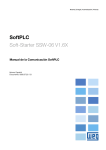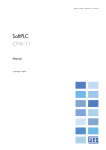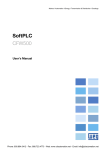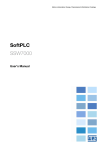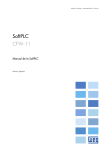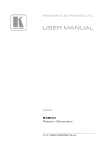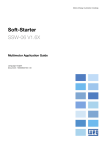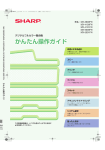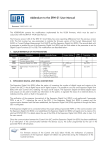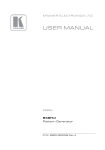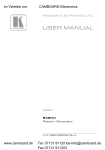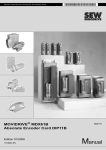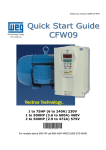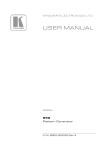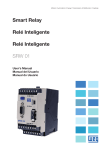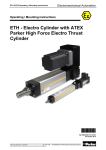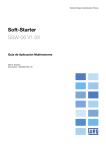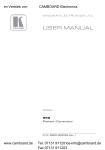Download SSW06 - SoftPLC Manual
Transcript
Motors | Energy | Automation | Coatings SoftPLC Soft-Starter SSW-06 V1.6X SoftPLC Communication Manual Language: English Document: 0899.5722 / 03 SoftPLC Communication Manual Series: SSW-06 V1.6X Language: English Document Number: 0899.5722 / 03 Publication Date: 09/2009 Summary . SUMMARY INFORMATION ABOUT THE MANUAL.........................................................5 ABBREVIATIONS AND DEFINITIONS .......................................................................................................... 5 NUMERICAL REPRESENTATION................................................................................................................. 5 1 INTRODUCTION TO THE SOFTPLC ..........................................................6 1.1 SYMBOLS AND DATA TYPES............................................................................................................... 6 2 SOFTPLC MEMORY ...................................................................................7 2.1 DATA MEMORY...................................................................................................................................... 7 2.1.1 Constants ...................................................................................................................................... 7 2.1.2 Physical Inputs and Outputs (Hardware) ................................................................................... 7 2.1.3 Volatile Markers (Variables) ......................................................................................................... 7 2.1.4 System Markers ............................................................................................................................ 8 2.1.5 Parameters .................................................................................................................................... 9 3 RESUME OF THE FUNCTION BLOCKS ..................................................10 3.1 CONTACTS ........................................................................................................................................... 10 3.1.1 Normally Open Contact – NO Contact...................................................................................... 10 3.1.2 Normally Closed Contact – NC Contact................................................................................... 10 3.1.3 And Logic With Contacts ........................................................................................................... 10 3.1.4 Or Logic With Contacts.............................................................................................................. 10 3.2 COILS .................................................................................................................................................... 11 3.2.1 Normal Coil – Coil ....................................................................................................................... 11 3.2.2 Negated Coil – Neg Coil ............................................................................................................. 11 3.2.3 Set Coil – Set Coil ....................................................................................................................... 11 3.2.4 Reset Coil – Reset Coil............................................................................................................... 11 3.2.5 Positive Transition Coil – PTS Coil............................................................................................ 11 3.2.6 Negative Transition Coil – NTS Coil.......................................................................................... 11 3.3 CLP BLOCKS........................................................................................................................................ 12 3.3.1 Timer – TON................................................................................................................................. 12 3.3.2 Incremental Counter– CTU ........................................................................................................ 12 3.4 CALCULATION BLOCKS ..................................................................................................................... 12 3.4.1 Comparator – COMP .................................................................................................................. 12 3.4.2 Math Operation – MATH............................................................................................................. 13 3.4.3 Math Function – FUNC ............................................................................................................... 13 3.4.4 Saturator – SAT ........................................................................................................................... 14 3.4.5 Multiplexer – MUX....................................................................................................................... 14 3.4.6 Demultiplexer – DMUX ............................................................................................................... 15 3.5 TRANSFER BLOCKS............................................................................................................................ 15 3.5.1 Data Transfer – TRANSFER ....................................................................................................... 15 3.5.2 Indirect Data Transfer – IDATA ................................................................................................. 16 3.6 MULTIMOTOR CONTROL– MMC ...................................................................................................... 16 4 SSW-06 PARAMETER SETTINGS............................................................17 4.1 SYMBOLS FOR THE PROPRIETIES DESCRIPTION ......................................................................... 17 4.2 CONFIGURATION PARAMETERS ...................................................................................................... 17 4.3 SOFTPLC EXCLUSIVE PARAMETERS ............................................................................................... 20 5 RESUME OF THE WLP MAIN FUNCTIONS.............................................22 5.1 5.2 5.3 5.4 5.5 5.6 PROJECT – NEW.................................................................................................................................. 22 PROJECT – OPEN ................................................................................................................................ 22 VIEW – COMPILATION INFO............................................................................................................... 22 CONSTRUCT – COMPILE.................................................................................................................... 23 COMMUNICATION – CONFIGURATION ............................................................................................ 23 COMMUNICATION – DOWNLOAD ..................................................................................................... 24 Summary . 5.7 COMMUNICATION – UPLOAD............................................................................................................ 24 Information About the Manual INFORMATION ABOUT THE MANUAL This manual provides the necessary description for the operation of the SSW-06 soft-starter using the user programming module denominated SoftPLC. This manual must be used together with the SSW-06 user manual and with the WLP software manual. ABBREVIATIONS AND DEFINITIONS PLC CRC RAM WLP Programmable Logic Controller Cycling Redundancy Check Random Access Memory Ladder Language Programming Software NUMERICAL REPRESENTATION Decimal numbers are represented by means of digits without suffix. Hexadecimal numbers are represented with the letter ‘h’ after the number. SSW-06 | 5 Introduction to the SoftPLC 1 INTRODUCTION TO THE SOFTPLC The SoftPLC is a feature that incorporates to the SSW-06 the functionalities of a PLC, adding flexibility to the product and allowing the user to develop applicative software (user programs). The SoftPLC main features are: ■ Ladder language programming, by using the WLP software; ■ Access to all the SSW-06 parameters and I/O’s; ■ 18 configurable user parameters; ■ PLC Mathematical and Control Blocks; ■ Applicative software transfer and online monitoring via serial (RS-232). ■ The cable (WEG Part Number: 10050215) shall be connected directly to the PC serial interface. 1.1 SYMBOLS AND DATA TYPES %KW %MX %MW %SX %SW %IX %QX %QW %PW %UW word type constants (16 bit) bit marker word marker (16 bit) system bit marker system word marker (16 bit) digital inputs digital outputs analog outputs (14 bit) system parameters user parameters SSW-06 | 6 SoftPLC Memory 2 SOFTPLC MEMORY The total size of the SoftPLC memory is 1024 bytes, between program memory and data memory. 2.1 DATA MEMORY The SoftPLC data memory area (user variables) is shared with the programming memory. Therefore, the total size of an applicative may vary as function of the amount of variables applied by the user. The bit and word markers are allocated according to the LAST address used in the applicative, i.e., the higher the last address the bigger the allocated area. Therefore, it is recommended to use the markers in a SEQUENTIAL manner. The word constants do also use program memory space. 2.1.1 CONSTANTS Table 2.1: Constant Memory Map Sym. %KW 2.1.2 Description Word Constants (16 bit) Bytes It depends on the quantity of different word constants. E.g.: If there were used: - %KW: 327 = 2 bytes - %KW: 5; 67 = 4 bytes - %KW: 13; 1000; 13; 4 = 6 bytes PHYSICAL INPUTS AND OUTPUTS (HARDWARE) Table 2.2: I/O Memory Map Sym. %IX %QX %QW 2.1.3 Description Digital inputs Digital outputs Analog outputs Range 1to 6 or 1 to 12 with K_IOE 1 ... 3 or 1 to 9 with K_IOE 1 ... 2 VOLATILE MARKERS (VARIABLES) They consist of variables that can be applied by the user to execute the applicative logics. They can be bit markers (1 bit) and word markers (16 bit). Table 2.3: Volatile Marker Memory Map Sym. %MX Description Bit markers Range 5000 ... 6099 %MW Word markers 8000 ... 8199 Bytes It depends on the last used marker. They are organized in byte pairs. E.g.: - last marker: %MX5000 = 2 bytes - last marker: %MX5014 = 2 bytes - last marker: %MX5016 = 4 bytes - last marker: %MX5039 = 6 bytes It depends on the last used marker. E.g.: - last marker: %MX8000 = 2 bytes - last marker: %MX8001 = 4 bytes - last marker: %MX8007 = 16 bytes NOTE! In order to minimize the applicative size, use the markers in a sequential manner. E.g.: Bit markers: %MX5000, %MX5001, %MX5002... Word markers: %MW8000, %MW8001, %MW8002... SSW-06 | 7 SoftPLC Memory 2.1.4 SYSTEM MARKERS They consist of special variables that allow the user to read and change SSW-06 soft-starter data that may or not be available in the parameters. They can be: system bit markers (1 bit) or system word markers (16 bit). Table 2.4.a: Memory Map for the Odd System Bits Sym. Type %SX Description System Bits Range 3000 ... 3040 Description writing/Commands (odd) 3001 Run/Stop 3003 General Enabling 3005 JOG 3007 Speed Direction 3009 LOC/REM 3015 Fault reset 0: It stops the motor. 1: It runs the motor. 0: It disables the soft-starter, interrupting the supply to the motor. 1: General enabling, allowing the motor operation. 0: It disables the JOG function. 1: It enables the JOG function. 0: It runs the motor in the clockwise direction. 1: It runs the motor in the counterclockwise direction. 0: It goes to the local mode. 1: It goes to the remote mode. 0: No function. 1: If in a fault condition, then it executes the SSW-06 reset. Table 2.4.b: Memory Map for the Even System Bits Sym. Type %SX Description System Bits Range 3000 ... 3040 Description Reading/State (Even) 3000 Motor Running 3002 General Enabling 3004 JOG 3006 In Acceleration 3008 In Current Limit 3010 At Full Voltage 3012 Alarm condition 3014 In Deceleration 3016 LOC/REM 3018 Braking 3020 Changing the speed direction 3022 Speed direction 3024 Bypass 3028 Supply at the power section 3030 Fault condition 0: The motor is stopped. 1: The motor is running, or executing either the acceleration or deceleration ramp, or braking. 0: General Enabling is not active. 1: General Enabling is active and the soft-starter is ready to run the motor. 0: Inactive JOG function. 1: Active JOG function. 0: It is not executing the acceleration ramp. 1: It is executing the acceleration ramp. 0: It is not in current limit. 1: It is in current limit. 0: The motor is not with full voltage. 1: The motor is with full voltage. 0: It is not in alarm condition. 1: It is in alarm condition. Note: The alarm number can be read iby means of the parameter P021 – Current Alarm. 0: It is not executing the deceleration ramp. 1: It is executing the deceleration ramp. 0: It is in local mode. 1: It is in remote mode. 0: It is not braking. 1: It is braking. 0: It is not executing the speed direction change. 1: It is executing the speed direction change. 0: The motor is rotating clockwise. 1: The motor is rotating counterclockwise. 0: It is not with closed bypass. 1: It is with closed bypass. 0: It is without supply at the power section. 1: It has a supply higher than 15V at the 3 phases of the power section. 0: It is not in a fault condition. 1: It is in fault condition. SSW-06 | 8 SoftPLC Memory Table 2.5: Memory Map for the System Word Markers Sym. %SW Description System Words Range 3300 ... 3303 Writing markers/Command (Odd) 3303 3305 2.1.5 User Fault (E86 to E89) User Alarm (A90 to A93) PARAMETERS The SSW-06 soft-starter parameter memory map is described in the table 2.6. Table 2.6 : Parameter Memory Map Sym. %PW Description System parameters (Refer to the SSW-06 manual) P088: SoftPLC status [Read-only parameter] P089: SoftPLC Allowed P204: Load/Save parameters P950: Enable SoftPLC %UW P951: Digital Inputs and Outputs Expansion Card Enable (K-IOE) User Parameters Range 0... 950 0: Without 1: Loading 2: Fault 3: Stopped 4: Running 0: No 1: Yes 13: Erase SoftPLC 14: Reset user parameters (P952 to P969 = 0) 0: No 1: Yes 0: No 1: Yes 952... 969 SSW-06 | 9 Resume of the Function Blocks 3 RESUME OF THE FUNCTION BLOCKS A resume of the function blocks that are available for the user programming, will be presented in this chapter. 3.1 CONTACTS They send to the stack the content of a programmed data (0 or 1), which may be of the type: ■ %MX: Bit Marker ■ %IX: Digital Input ■ %QX: Digital Output ■ %UW: User Parameter ■ %SX: System Bit Marker - Reading NOTE! If contacts with parameters are used (%UW), they are set when the parameter value is different from zero. In the logic examples below, the %UW952 contact is considered active if the parameter P952 is different from zero. 3.1.1 NORMALLY OPEN CONTACT – NO CONTACT Menu: Insert – Contacts – Normally Open Contact. E.g.: It sends to the stack the content of the bit marker 5000. 3.1.2 NORMALLY CLOSED CONTACT – NC CONTACT Menu: Insert – Contacts – Normally Closed Contact. E.g.: It sends to the stack the negated content of the digital output 1. 3.1.3 AND LOGIC WITH CONTACTS When the contacts are in series, an AND logic is executed among them, storing the result in the stack. Examples: Example %IX1 . %IX2 %UW952 . (~%QX1) 3.1.4 %IX1 0 0 1 1 %UW952 0 0 1 1 Truth Table %IX2 0 1 0 1 %QX1 0 1 0 1 Stack 0 0 0 1 Stack 0 0 1 0 OR LOGIC WITH CONTACTS When the contacts are in parallel, an OR logic is executed among them, storing the result in the stack. Examples: SSW-06 | 10 Resume of the Function Blocks Example 3.2 Operation Truth Table %IX2 Stack 0 0 1 1 1 0 1 1 %IX1 + %IX2 %IX1 0 0 1 1 %UW952+ (~%QX1) %UW952 0 0 1 1 %QX1 0 1 0 1 Stack 1 0 1 1 COILS They save the stack content (0 or 1) in the programmed element: ■ %MX: Bit Marker ■ %QX: Digital Output ■ %UW: User Parameter ■ %SX: System Bit Marker – Writing It is allowed to add coils in parallel at the last column. 3.2.1 NORMAL COIL – COIL Menu: Insert – Coils – Coil. E.g.: It sets the bit marker 5001 with the stack content. 3.2.2 NEGATED COIL – NEG COIL Menu: Insert – Coils – Negated Coil. E.g.: It sets the digital output 2 with the negated content of the stack. 3.2.3 Set Coil – Set Coil Menu: Insert – Coils – Set Coil. E.g.: It sets the user parameter P960, provided that the content of the stack is not 0. 3.2.4 Reset Coil – Reset Coil Menu: Insert – Coils – Reset Coil. E.g.: It resets the user parameter P960, provided that the content of the stack is not 0. 3.2.5 Positive Transition Coil – PTS Coil Menu: Insert – Coils – PTS Coil. E.g.: It sets the bit marker 5002 during 1 scan cycle, provided that a transition from 0 to 1 in the stack is detected. 3.2.6 Negative Transition Coil – NTS Coil Menu: Insert – Coils – NTS Coil. E.g.: It sets the system bit marker 3011 during 1 scan cycle, provided that a transition from 1 to 0 in the stack is detected. SSW-06 | 11 Resume of the Function Blocks 3.3 3.3.1 CLP BLOCKS Timer – TON Menu: Insert - Function Blocks – PLC-TON. Input: IN: Enables the block. Output: Q: Goes to 1 when IN ≠0 and ET ≥ PT. Proprieties: PT: Programmed Time (Preset Time). ET: Elapsed Time. If the IN input is active and the content of the word marker 8000 is higher or equal than the content of the user parameter P955, the output Q is set. 3.3.2 Incremental Counter– CTU Menu: Insert - Function Blocks – PLC-CTU. Inputs: CU: Captures the transitions from 0 to 1 at this input (Counter Up). R: Resets CV. Output: Q: Goes to 1 when CV ≥ PV. Proprieties: PV: Programmed Value (Preset Value). CV: Counter Value. If the content of the word marker 8001 is higher or equal than 20, the output Q is set. 3.4 3.4.1 CALCULATION BLOCKS Comparator – COMP Menu: Insert - Function Blocks – Calculation-COMP. Input: EN: Enables the block. Output: ENO: Goes to 1 when the comparison condition is fulfilled. Proprieties: FORMAT: Only Integer. DATA 1: Comparison data 1. OPERATOR: Comparison operator. DATA 2: Comparison data 2. If the EN input is active and the content of the word marker 8000 is higher than the content of the word marker 8001, then the output ENO is set. NOTE! All the numeric data are considered words of 15 bit + sign (-32768 to 32767). SSW-06 | 12 Resume of the Function Blocks 3.4.2 MATH Operation – MATH Menu: Insert - Function Blocks – Calculation-MATH. Input: EN: Enables the block. Output: ENO: Indicates if the calculation has been executed. Proprieties: FORMAT: Integer or floating point. DATA1: Calculation data 1. It may also appear as DATA1H and DATA1L (representing the high and low parts of the data 1). OPERATOR: Mathematic operator (+, -, *, etc). DATA2: Calculation data 2. It may also appear as DATA2H and DATA2L (representing the high and low parts of the data 2). RES: Calculation result. It may also appear as RESH and RESL (representing the high and low parts of the result) and also as QUOC and REM (representing the quotient and the reminder of a division). OVER: Indicates if the result exceeded its limit. SIGNAL: Result sign. When EN input is active, the value of the word marker is incremented to each cycle of scan. When the bit marker 5000 goes for 1, indicates that it had a overflow limit and the word marker 8000 remains in 32767. NOTE! All the numeric data are considered words of 15 bit + sign (-32768 to 32767). 3.4.3 MATH Function – FUNC Menu: Insert - Function Blocks – Calculation-FUNC. Input: EN: Enables the block. Output: ENO: Indicates if the calculation has been executed. Proprieties: FORMAT: Only Integer. IN: Data to be calculated. FUNCTION: Mathematic function: abs (module) and neg (negative). OUT: Calculation result. When the EN input is active, the word marker 8001 presents the module of the word marker 8000. NOTE! All the numeric data are considered words of 15 bit + sign (-32768 to 32767). SSW-06 | 13 Resume of the Function Blocks 3.4.4 Saturator – SAT Menu: Insert - Function Blocks – Calculation-SAT. Input: EN: Enables the block. Output: ENO: Indicates if saturation has occurred, provided that EN ≠ 0. Proprieties: FORMAT: Only Integer. IN: Input data. MAX: Maximum allowed value. MIN: Minimum allowed value. OUT: Output data. When the EN input is active, the word marker 8000 contains the user parameter P952 value, limited however between the maximum of 100 and the minimum of -100. NOTE! If the minimum value is higher than the maximum, the outputs OUT and ENO are reset to zero. NOTE! All the numeric data are considered words of 15 bit + sign (-32768 to 32767). 3.4.5 Multiplexer – MUX Menu: Insert - Function Blocks – Calculation-MUX. Input: EN: Enables the mathematic operation. Output: ENO: Indicates that the transfer has been done. Proprieties: X0-X15: Binary data vector. W: Resulting word. When the EN input is active, the digital inputs 1, 2 and 3 transfer their content to the bits 0, 1 and 2 of the user parameter P952. SSW-06 | 14 Resume of the Function Blocks 3.4.6 Demultiplexer – DMUX Menu: Insert - Function Blocks – Calculation-MUX. Input: EN: Enables the mathematic operation. Output: ENO: Indicates that the transfer has been done. Proprieties: W: Source word. X0-X15: Resulting binary data vector. When the EN input is active, the bits 1, 2, 5, 6, 11, 13 and 15 of the word marker 8000 are transferred respectively to the bit markers 5001, 5002, 5005, 5006, 5011, 5013 and 5015. 3.5 3.5.1 TRANSFER BLOCKS Data Transfer – TRANSFER Menu: Insert - Function Blocks- Transfer-TRANSFER. Input: EN: Enables the block. Output: ENO: Indicates that the transfer has been done. Proprieties: SRC: Source data. DST: Destine data. In the example above, if the EN input is active, the word constant 1 is transferred to the system bit marker 3001 (Run/Stop). TRANSFER for the generation of user faults and alarms In order to generate the user alarms A90 to A93 and the user faults E96 to E99, the TRANSFER block must be used according to the examples below. The fault reset may come from the system bit marker %SX3011, or from other reset source (HMI, DIx, etc.). E86 fault generated with the transfer block. A90 alarm generated with the transfer block. NOTE! By using user faults, precaution must be taken in order to avoid that the transfer block EN input does not stay always active, with a reset also always active. This would cause the soft-starter SSW-06 to stay in a fault and reset loop, as showed below. SSW-06 | 15 Resume of the Function Blocks Logic for the fault and reset loop. NOTE! The user alarms can only be reset with the command coming through the SoftPLC, in this case the SCR of the transfer block must contain the value zero. The SSW-06 soft-starter alarms can be reset only by the source that has generated them. 3.5.2 Indirect Data Transfer – IDATA Menu: Insert - Function Blocks- Transfer -IDATA. Input: EN: Enables the block. Output: ENO: Indicates that the transfer has been done. Proprieties: CMD: Read/Write command DATATYPE: Data type ADDRESS: User address. VALUE: Read content/Value to be written In the example above, if the EN input is active, the content of the bit marker 5000 is written to the digital output whose address is the content of the word marker 8000. 3.6 Multimotor Control – MMC Menu: Insert-Function Block multimotor control-MMC Input: EN: Enables the block. Output: ENO: Indicates that the block is active. Proprieties: MotorX START: Enable the motor in 1. STOP: Disable the motor in 0. FAULT: Disable the motor in 0. STARTING: Indicates motor starting or stopping. BYPASS: Indicates by-pass on. SRC1: Source data. SRC2: Source data. SRC3: Source data. DST1: Destine data. DST2: Destine data. DST2: Destine data. In the example above, through the MMC you can control the start and stop of up to three different motors only one Soft-Starter SSW-06. SSW-06 | 16 SSW-06 Parameter Settings 4 SSW-06 PARAMETER SETTINGS In the continuation, only the parameters of the SSW-06 soft-starter that are related to the SoftPLC will be presented, remembering that all the parameters are accessible, except for the parameters P200 and P215. Refer to the SSW-06 manual for more details. 4.1 SYMBOLS FOR THE PROPRIETIES DESCRIPTION Read-only parameter. Parameter that can be changed only with a stopped motor. RO CFG 4.2 CONFIGURATION PARAMETERS P220 – LOCAL/REMOTE Source Selection Adjustable Range: 0 = Always LOCAL 1 = Always REMOTE 2 = Keypad (L) 3 = Keypad (R) 4 = DI4 to DI6 5 = Serial (L) 6 = Serial (R) 7 = Fieldbus (L) 8 = Fieldbus (R) 9 = SoftPLC (L) 10 = SoftPLC (R) Factory Setting: 2 Proprieties: CFG Description: It defines the origin of the command that will select between the LOCAL situation and the REMOTE situation. Default situation is the one assumed when the Soft-Starter SSW-06 is powered-up (initialization). Table 4: OCAL / REMOTE Selection P220 0 1 2 3 4 5 6 7 8 9 10 LOCAL / REMOTE Selection Always Local situation Always Remote situation HMI key (Default LOCAL) HMI key (Default REMOTE) Digital inputs from DI1 to DI6 (P266 to P268) Serial (Default Local) – SuperDrive or incorporated Modbus Serial (Default Remote) – SuperDrive or incorporated Modbus Fieldbus (Default Local) – Optional interface module Fieldbus (Default Remote) – Optional interface module SoftPLC (Default Local) SoftPLC (Default Remote) P229 – Command Selection – LOCAL Situation P230 – Command Selection – REMOTE Situation Adjustable Range: 0 = HMI keys 1 = Digital input DIx 2 = Serial 3 = Fieldbus 4 = SoftPLC Factory Setting: P230 = 1 P229 = 0 SSW-06 | 17 SSW-06 Parameter Settings Proprieties: CFG Description: They define the origin of the commands for running and stopping the SSW-06 soft-starter. Table 4.2: LOCAL / REMOTE Command Selection P229/P230 0 1 2 3 4 LOCAL / REMOTE Command Selection HMI keys Digital input DIx Serial communication Fieldbus communication (DeviceNet or Profibus DP) SoftPLC P251 – AO1 Function (0 to 10V) P253 – AO2 Function (0 to 20mA or 4 to 20mA) Adjustable Range: 0 = Not used 1 = SSW current (% of the SSW In) 2 = Line Voltage (% of the SSW Un) 3 = Output voltage (% of the SSW Un) 4 = Power factor 5 = Thermal protection 6 = Power (in W) 7 = Power (in VA) 8 = Torque (% of the motor Tn) 9 = Fieldbus 10 = Serial 11 = SoftPLC Factory Setting: P251 = 0 P253 = 0 Description: These parameters set the functions of the analog outputs, according to the table 4.6. The value of the analog outputs can be read at the parameters P027 (AO1) and P028 (AO2). Those values are converted to voltage and current using the full scale values as showed in the table below. Thus, if the AO1 was programmed for SoftPLC (P251 = 11) and the value 16383 is written, the analog output will present 10v. The same criteria is valid for the analog output in current (AO2), where the value 16383 will be equal to 20mA and 0 will be either equal to 0mA or to 4mA, depending on the analog output programming (P255=0 (0 to 20mA) or P255=1 (4 to 20mA)). Table 4.6: Analog output functions Functions P251 (AO1) P253 (AO2) Full scale when Not used SSW current in % of the SSW In Line Voltage in % of the SSW Un Output voltage in % of the SSW Un Power factor Thermal protection Power in W Power in VA Torque in % of the motor Tn Fieldbus Serial SoftPLC 0 1 2 3 4 5 6 7 8 9 10 11 0 1 2 3 4 5 6 7 8 9 10 11 5 x P295 1.5 x P296(max.) 1.5 x P296(max.) P008 = 1.00 P050 = 250% 1.5 x √3 x P295 x P296(max.) x P008 1.5 x √3 x P295 x P296(max.) P009 = 100% 16383 (3FFFh) 16383 (3FFFh) 16383 (3FFFh) SSW-06 | 18 SSW-06 Parameter Settings P277 – DO1 Function (RL1) P278 – DO2 Function (RL2) P279 – DO3 Function (RL3) Adjustable Range: 0 = Not used Factory Setting: P277 = 1 1 = Running P278 = 2 2 = Full Voltage P279 = 6 3 = External Bypass 4 = FWD/REV-K1 (P277) / FWD/REV-K2 (P278) / Not used (P279) 5 = DC braking 6 = No Fault 7 = Fault 8 = Fieldbus 9 = Serial 10 = SoftPLC 11 = No Alarm 12 = Alarm Description: They program the functions of the digital outputs, according to the options presented previously. When the condition declared by the function is true, the digital output will be activated. The status of the digital outputs can be monitored via the parameter P013. P308 – Soft-Starter address on the Serial Communication Network Adjustable Range: 1 to 247 Factory Setting: 1 Description: This parameter sets the address of the SSW-06 soft-starter in the serial communication network. The SSW-06 soft-starter must be configured exactly as in the WLP software (refer to item 5.6), so that the user software download/upload be possible. P312 – Protocol Type and Baud Rate of the Serial Adjustable Range: 1 = Modbus-RTU (9600bps, no parity) 2 = Modbus-RTU (9600bps, odd) 3 = Modbus-RTU (9600bps, even) 4 = Modbus-RTU (19200bps, no parity) 5 = Modbus-RTU (19200bps, odd) 6 = Modbus-RTU (19200bps, even) 7 = Modbus-RTU (38400bps, no parity) 8 = Modbus-RTU (38400bps, odd) 9 = Modbus-RTU (38400bps, even) Factory Setting: 1 Description: This parameter sets the serial protocol and the baud rate. The SSW-06 soft-starter must be configured exactly as in the WLP software (refer to item 5.6), so that the user software download/upload be possible. SSW-06 | 19 SSW-06 Parameter Settings 4.3 SOFTPLC EXCLUSIVE PARAMETERS P088 – SoftPLC Status Adjustable Range: 0 = Without 1 = Loading 2 = Fault 3 = Stopped 4 = Running Factory Setting: - Proprieties: RO Description: It allows to the user to visualize the SoftPLC status. If there is no installed applicative, the parameter P088 will show the option 0 (Without). If this parameter presents the option 2 (Fault), it indicates that the user software loaded with the WLP is incompatible with the SSW-06 firmware version, or that an error occurred during the program download. In this case it is necessary to recompile the project in the WLP, considering the new SSW-06 version, and to download it again. If this is not possible, the upload of this applicative with the WLP can be done. The options 3 (Stopped) and 4 (Running) are related to the parameter P950 (Enable SoftPLC). P089 - SoftPLC Allowed Adjustable Range: 0 = No 1 = Yes Factory Setting: - Proprieties: CFG Description: The SSW-06 soft-starter SoftPLC feature is available from the firmware version V1.40 on; however, it is necessary to upgrade the control board to one with more memory in order to allow the SoftPLC operation. Therefore, the parameter P089 verifies whether the hardware version is compatible (P089 = 1) or not (P089 = 0). P204 – Load/Save Parameters Adjustable Range: 0 = Not used 1 = Not used 2 = Not used 3 = Reset P043 to P050 4 = Reset P053 to P058 5 = Load Default 6 = Not used 7 = Load User 1 8 = Load User 2 9 = Not used 10 = Save User 1 11 = Save User 2 12 = Not used 13 = Erase SoftPLC 14 = Reset SoftPLC (P952 to P969) 15 = Reserved 16 = Reserved Factory Setting: 0 Proprieties: CFG SSW-06 | 20 SSW-06 Parameter Settings Description: The parameter P204 loads, saves and resets several parameters, as describe in the list above. The options related to the SoftPLC are: the option 13, which erases the user program, and the 14, which resets the user parameters P952 to P969. P950 – Enable SoftPLC Adjustable Range: 0 = No 1 = Yes Factory Setting: 0 Proprieties: CFG Description: It makes it possible to run and to stop an installed applicative, but therefore the motor must be disabled. P951 – Digital Inputs and Outputs Expansion Card Enable Adjustable Range: 0 = No 1 = Yes Factory Setting: 0 Proprieties: CFG Description: It makes it possible to enable digital inputs and outputs expansion card of Kit K-IOE, with: six digital inputs 24Vcc (of DI7 to DI12) and six digital relay outputs(of RL4 to RL9). P952 to P969 – SoftPLC Parameters Adjustable Range: 0 to 65535 Factory Setting: 0 Description: They consist of parameters with functions defined by the user by means of the WLP software. SSW-06 | 21 Resume of the WLP Main Functions 5 RESUME OF THE WLP MAIN FUNCTIONS This chapter brings basic information about the operations done with the WLP software for the SSW-06 softstarter programming. More information can be obtained in the manual or in the help of the WLP software. 5.1 PROJECT – NEW It creates a new project. Besides defining the project name, it is also necessary to configure the equipment and the respective firmware version. 5.2 PROJECT – OPEN It opens the selected project. 5.3 VIEW – COMPILATION INFO It allows the user to know the compiled applicative size in bytes (<projectname>.bin) to be sent to the equipment. SSW-06 | 22 Resume of the WLP Main Functions 5.4 CONSTRUCT – COMPILE It analyses the applicative and generates the code for the specified equipment. 5.5 COMMUNICATION – CONFIGURATION The serial port is used for the communication with the SSW-06. Therefore, both the SSW-06 and the WLP baud rate must be configured correctly. SSW-06 | 23 Resume of the WLP Main Functions 5.6 COMMUNICATION – DOWNLOAD This command allows downloading the applicative to the SSW-06. 5.7 COMMUNICATION – UPLOAD This command makes it possible to upload the applicative installed in the SSW-06. SSW-06 | 24
























